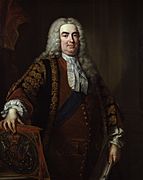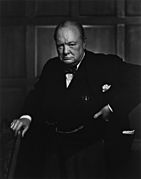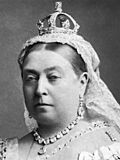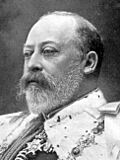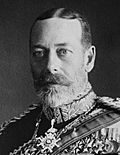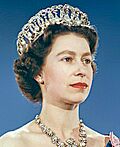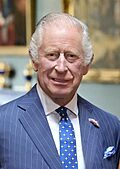List of prime ministers of the United Kingdom facts for kids
- Top left: Robert Walpole is seen as the first prime minister of Great Britain.
- Top right: Winston Churchill was prime minister during World War II.
- Bottom left: Margaret Thatcher was the first female prime minister.
- Bottom right: Keir Starmer is the current prime minister.
The prime minister of the United Kingdom is the leader of the U.K. government. They are the main advisor to the monarch and in charge of the British Cabinet, which is a team of senior government ministers.
The job of prime minister wasn't created on a single day. Instead, it developed slowly over many years. The name "prime minister" started being used for Sir Robert Walpole in the 1730s, but it was just a nickname then. It didn't become an official title until 1905.
Most historians agree that Robert Walpole was the first prime minister. He led the government for over 20 years, starting in 1721. This makes him the longest-serving prime minister ever.
The first prime minister to officially use the title in a document was Benjamin Disraeli, who signed a treaty in 1878 as "Prime Minister of Her Britannic Majesty".
The current prime minister is Keir Starmer, who took office on 5 July 2024.
Contents
How the Job of Prime Minister Began
Before the countries of England and Scotland joined to form the Kingdom of Great Britain in 1707, the English government's money was often managed by the Lord High Treasurer. This person was one of the most powerful people in the government.
After 1714, when King George I came to the throne, this system changed. Instead of one person, a team called the Lords of the Treasury managed the country's finances. The leader of this team was called the First Lord of the Treasury.
From 1721, the person who was the First Lord of the Treasury was usually also the most powerful person in government. This is why Robert Walpole, who was First Lord from 1721 to 1742, is seen as the first prime minister. The prime minister today still holds the title of First Lord of the Treasury as part of the job.
List of Prime Ministers Since 1721
-
-
-
- Conservative (20)
- Whig (16)
- Tory (10)
- Labour (7)
- Liberal (7)
- Scottish Unionists (2)
- National Labour (1)
- Peelite (1)
| Portrait | Prime minister
(lifespan)
|
Term of office | Mandate | Party | Government | Monarch
Reign
|
|||
|---|---|---|---|---|---|---|---|---|---|
| Start | End | Duration | |||||||
| |  |
Robert Walpole
(1676–1745)
|
3 April
1721 |
11 February
1742 |
20 years, 315 days | 1722 | Whig | Walpole– |
George I
r. 1714 – 1727
|
| 1727 | George II
r. 1727 – 1760
|
||||||||
| 1734 | Walpole | ||||||||
| 1741 | |||||||||
 |
Spencer Compton
1st Earl of Wilmington
|
16 February
1742 |
2 July
1743 |
1 year, 137 days | — | Carteret | |||
 |
Henry Pelham
(1694–1754)
|
27 August
1743 |
6 March
1754 |
10 years, 192 days | — | Broad Bottom I | |||
| 1747 | Broad Bottom II | ||||||||
 |
Thomas Pelham-Holles
1st Duke of Newcastle
|
16 March
1754 |
11 November
1756 |
2 years, 241 days | 1754 | Newcastle I | |||
 |
William Cavendish |
16 November
1756 |
29 June
1757 |
226 days | — | Pitt– |
|||
| 1757 Caretaker | |||||||||
 |
Thomas Pelham-Holles
1st Duke of Newcastle
|
29 June
1757 |
26 May
1762 |
4 years, 332 days | 1761 | Pitt– |
|||
| Bute– |
George III
r. 1760 – 1820
|
||||||||
 |
John Stuart
3rd Earl of Bute
|
26 May
1762 |
8 April
1763 |
318 days | — | Tory | Bute | ||
 |
George Grenville
(1712–1770)
|
16 April
1763 |
10 July
1765 |
2 years, 86 days | — | Whig
(Grenvillite)
|
Grenville
(mainly Whig)
|
||
 |
Charles Watson-Wentworth
2nd Marquess of Rockingham
|
13 July
1765 |
30 July
1766 |
1 year, 18 days | — | Whig
(Rockinghamite)
|
Rockingham I | ||
 |
William Pitt the Elder
|
30 July
1766 |
14 October
1768 |
2 years, 77 days | 1768 | Whig | Chatham | ||
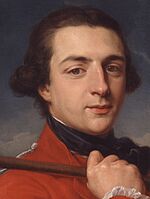 |
Augustus FitzRoy
3rd Duke of Grafton
|
14 October
1768 |
28 January
1770 |
1 year, 107 days | — | Grafton | |||
 |
Frederick North |
28 January
1770 |
27 March
1782 |
12 years, 59 days | 1774 | Tory
(Northite)
|
North | ||
| 1780 | |||||||||
 |
Charles Watson-Wentworth
2nd Marquess of Rockingham
|
27 March
1782 |
1 July
1782 |
97 days | — | Whig
(Rockinghamite)
|
Rockingham II | ||
 |
William Petty
2nd Earl of Shelburne
|
4 July
1782 |
26 March
1783 |
266 days | — | Whig | Shelburne | ||
 |
William Cavendish-Bentinck
3rd Duke of Portland
|
2 April
1783 |
18 December
1783 |
261 days | — | Whig | Fox–North | ||
 |
William Pitt the Younger
(1759–1806)
|
19 December
1783 |
14 March
1801 |
17 years, 86 days | 1784 | Tory
(Pittite)
|
Pitt I | ||
| 1790 | |||||||||
| 1796 | |||||||||
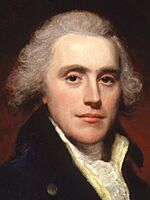 |
Henry Addington
(1757–1844)
|
17 March
1801 |
10 May
1804 |
3 years, 55 days | 1801 | Tory | Addington | ||
| 1802 | |||||||||
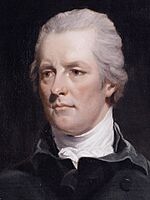 |
William Pitt the Younger
(1759–1806)
|
10 May
1804 |
23 January
1806 |
1 year, 259 days | — | Tory
(Pittite)
|
Pitt II | ||
 |
William Grenville
1st Baron Grenville
|
11 February
1806 |
25 March
1807 |
1 year, 43 days | 1806 | Whig | All the Talents | ||
 |
William Cavendish-Bentinck
3rd Duke of Portland
|
31 March
1807 |
4 October
1809 |
2 years, 188 days | 1807 | Tory
(Pittite)
|
Portland II | ||
 |
Spencer Perceval
(1762–1812)
|
4 October
1809 |
11 May
1812(Killed while in office) |
2 years, 221 days | — | Perceval | |||
 |
Robert Jenkinson
2nd Earl of Liverpool
|
8 June
1812 |
9 April
1827 |
14 years, 306 days | 1812 | Liverpool | |||
| 1818 | George IV
r. 1820 – 1830
|
||||||||
| 1820 | |||||||||
| 1826 | |||||||||
 |
George Canning
(1770–1827)
|
12 April
1827 |
8 August
1827 |
119 days | — | Tory
(Canningite)
|
Canning
(Canningite–
|
||
 |
Frederick John Robinson
1st Viscount Goderich
|
31 August
1827 |
8 January
1828 |
131 days | — | Tory
(Canningite)
|
Goderich | ||
 |
Arthur Wellesley |
22 January
1828 |
16 November
1830 |
2 years, 299 days | — | Tory | Wellington– |
||
| (1830) | William IV
r. 1830 – 1837
|
||||||||
 |
Charles Grey
2nd Earl Grey
|
22 November
1830 |
9 July
1834 |
3 years, 230 days | 1831 | Whig | Grey | ||
| 1832 | |||||||||
 |
William Lamb
2nd Viscount Melbourne
|
16 July
1834 |
14 November
1834 |
122 days | — | Melbourne I | |||
 |
Arthur Wellesley |
17 November
1834 |
9 December
1834 |
23 days | (—) | Tory | Wellington Caretaker | ||
 |
Robert Peel
(1788–1850)
|
10 December
1834 |
8 April
1835 |
120 days | (—) | Conservative | Peel I | ||
 |
William Lamb
2nd Viscount Melbourne
|
18 April
1835 |
30 August
1841 |
6 years, 135 days | 1835 | Whig | Melbourne II | ||
| 1837 | Victoria
r. 1837 – 1901
|
||||||||
 |
Robert Peel
(1788–1850)
|
30 August
1841 |
29 June
1846 |
4 years, 304 days | 1841 | Conservative | Peel II | ||
 |
John Russell
(1792–1878)
|
30 June
1846 |
21 February
1852 |
5 years, 237 days | (1847) | Whig | Russell I | ||
 |
Edward Smith-Stanley
14th Earl of Derby
|
23 February
1852 |
17 December
1852 |
299 days | 1852 | Conservative | Who? Who? | ||
 |
George Hamilton-Gordon
4th Earl of Aberdeen
|
19 December
1852 |
30 January
1855 |
2 years, 43 days | (—) | Peelite | Aberdeen | ||
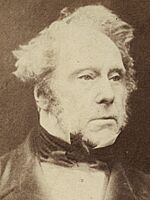 |
Henry John Temple
3rd Viscount Palmerston
|
6 February
1855 |
19 February
1858 |
3 years, 14 days | 1857 | Whig | Palmerston I | ||
 |
Edward Smith-Stanley
14th Earl of Derby
|
20 February
1858 |
11 June
1859 |
1 year, 112 days | (—) | Conservative | Derby– |
||
 |
Henry John Temple
3rd Viscount Palmerston
|
12 June
1859 |
18 October
1865 |
6 years, 129 days | 1859 | Liberal | Palmerston II | ||
| 1865 | |||||||||
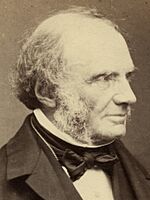 |
John Russell
1st Earl Russell
|
29 October
1865 |
26 June
1866 |
241 days | — | Russell II | |||
 |
Edward Smith-Stanley
14th Earl of Derby
|
28 June
1866 |
25 February
1868 |
1 year, 243 days | (—) | Conservative | Derby– |
||
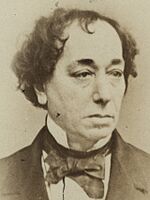 |
Benjamin Disraeli
|
27 February
1868 |
1 December
1868 |
279 days | (—) | ||||
 |
William Ewart Gladstone
|
3 December
1868 |
17 February
1874 |
5 years, 77 days | 1868 | Liberal | Gladstone I | ||
 |
Benjamin Disraeli
|
20 February
1874 |
21 April
1880 |
6 years, 62 days | 1874 | Conservative | Disraeli II | ||
 |
William Ewart Gladstone
|
23 April
1880 |
9 June
1885 |
5 years, 48 days | 1880 | Liberal | Gladstone II | ||
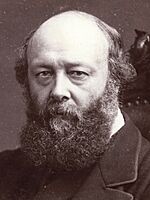 |
Robert Gascoyne-Cecil
3rd Marquess of Salisbury
|
23 June
1885 |
28 January
1886 |
220 days | (—) | Conservative | Salisbury I | ||
 |
William Ewart Gladstone
|
1 February
1886 |
20 July
1886 |
170 days | (1885) | Liberal | Gladstone III | ||
 |
Robert Gascoyne-Cecil
3rd Marquess of Salisbury
|
25 July
1886 |
11 August
1892 |
6 years, 18 days | (1886) | Conservative | Salisbury II | ||
 |
William Ewart Gladstone
|
15 August
1892 |
2 March
1894 |
1 year, 200 days | (1892) | Liberal | Gladstone IV | ||
 |
Archibald Primrose
5th Earl of Rosebery
|
5 March
1894 |
22 June
1895 |
1 year, 110 days | (—) | Rosebery | |||
 |
Robert Gascoyne-Cecil
3rd Marquess of Salisbury
|
25 June
1895 |
11 July
1902 |
7 years, 17 days | 1895 | Conservative | Salisbury III
(Con–
|
||
| 1900 | Salisbury IV
(Con–
|
||||||||
| Edward VII
r. 1901 – 1910
|
|||||||||
 |
Arthur Balfour
(1848–1930)
|
12 July
1902 |
4 December
1905 |
3 years, 146 days | — | Balfour
(Con–
|
|||
 |
Henry Campbell-Bannerman
(1836–1908)
|
5 December
1905 |
3 April
1908 |
2 years, 121 days | 1906 | Liberal | Campbell-Bannerman | ||
 |
H. H. Asquith
(1852–1928)
|
8 April
1908 |
5 December
1916 |
8 years, 243 days | — | Asquith I | |||
| (Jan.1910) | Asquith II | George V
r. 1910 – 1936
|
|||||||
| (Dec.1910) | Asquith III | ||||||||
| (—) | Asquith Coalition | ||||||||
 |
David Lloyd George
(1863–1945)
|
6 December
1916 |
19 October
1922 |
5 years, 318 days | (—) | Lloyd George War | |||
| 1918 | Lloyd George II | ||||||||
 |
Bonar Law
(1858–1923)
|
23 October
1922 |
20 May
1923 |
210 days | 1922 | Conservative
(Scot.U.)
|
Law | ||
 |
Stanley Baldwin
(1867–1947)
|
22 May
1923 |
22 January
1924 |
246 days | — | Conservative | Baldwin I | ||
 |
Ramsay MacDonald
(1866–1937)
|
22 January
1924 |
4 November
1924 |
288 days | (1923) | Labour | MacDonald I | ||
 |
Stanley Baldwin
(1867–1947)
|
4 November
1924 |
4 June
1929 |
4 years, 213 days | 1924 | Conservative | Baldwin II | ||
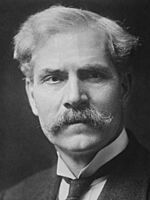 |
Ramsay MacDonald
(1866–1937)
|
5 June
1929 |
7 June
1935 |
6 years, 3 days | (1929) | Labour | MacDonald II | ||
| (—) | National Labour | National I | |||||||
| 1931 | National II | ||||||||
| |  |
Stanley Baldwin
(1867–1947)
|
7 June
1935 |
28 May
1937 |
1 year, 356 days | 1935 | Conservative | National III | |
| Edward VIII
r.
|
|||||||||
| George VI
r. 1936 – 1952
|
|||||||||
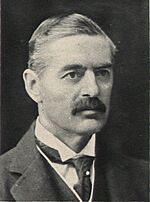 |
Neville Chamberlain
(1869–1940)
|
28 May
1937 |
10 May
1940 |
2 years, 349 days | — | National IV | |||
| Chamberlain War | |||||||||
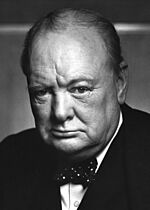 |
Winston Churchill
(1874–1965)
|
10 May
1940 |
26 July
1945 |
5 years, 78 days | — | Churchill War | |||
| Churchill Caretaker
(Con–
|
|||||||||
 |
Clement Attlee
(1883–1967)
|
26 July
1945 |
26 October
1951 |
6 years, 93 days | 1945 | Labour | Attlee I | ||
| 1950 | Attlee II | ||||||||
 |
Winston Churchill
(1874–1965)
|
26 October
1951 |
5 April
1955 |
3 years, 162 days | 1951 | Conservative | Churchill III | ||
| Elizabeth II
r. 1952 – 2022
|
|||||||||
 |
Anthony Eden
(1897–1977)
|
6 April
1955 |
9 January
1957 |
1 year, 279 days | 1955 | Eden | |||
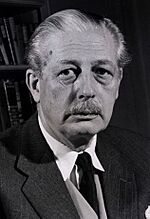 |
Harold Macmillan
(1894–1986)
|
10 January
1957 |
18 October
1963 |
6 years, 282 days | — | Macmillan I | |||
| 1959 | Macmillan II | ||||||||
 |
Alec Douglas-Home
(1903–1995)
|
18 October
1963 |
16 October
1964 |
365 days | — | Conservative
(Scot.U.)
|
Douglas-Home | ||
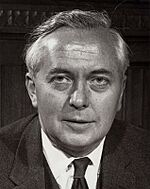 |
Harold Wilson
(1916–1995)
|
16 October
1964 |
19 June
1970 |
5 years, 247 days | 1964 | Labour | Wilson I | ||
| 1966 | Wilson II | ||||||||
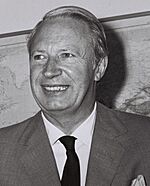 |
Edward Heath
(1916–2005)
|
19 June
1970 |
4 March
1974 |
3 years, 259 days | 1970 | Conservative | Heath | ||
 |
Harold Wilson
(1916–1995)
|
4 March
1974 |
5 April
1976 |
2 years, 33 days | (Feb.1974) | Labour | Wilson III | ||
| Oct.1974 | Wilson IV | ||||||||
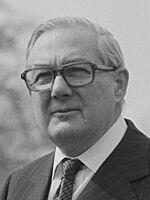 |
James Callaghan
(1912–2005)
|
5 April
1976 |
4 May
1979 |
3 years, 30 days | — | Callaghan | |||
 |
Margaret Thatcher
|
4 May
1979 |
28 November
1990 |
11 years, 209 days | 1979 | Conservative | Thatcher I | ||
| 1983 | Thatcher II | ||||||||
| 1987 | Thatcher III | ||||||||
 |
John Major
|
28 November
1990 |
2 May
1997 |
6 years, 156 days | — | Major I | |||
| 1992 | Major II | ||||||||
 |
Tony Blair
|
2 May
1997 |
27 June
2007 |
10 years, 57 days | 1997 | Labour | Blair I | ||
| 2001 | Blair II | ||||||||
| 2005 | Blair III | ||||||||
 |
Gordon Brown
|
27 June
2007 |
11 May
2010 |
2 years, 319 days | — | Brown | |||
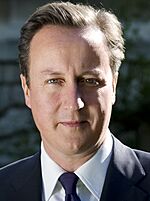 |
David Cameron
|
11 May
2010 |
13 July
2016 |
6 years, 64 days | (2010) | Conservative | Cameron–Clegg | ||
| 2015 | Cameron II | ||||||||
 |
Theresa May
|
13 July
2016 |
24 July
2019 |
3 years, 12 days | — | May I | |||
| (2017) | May II (DUP confidence & supply) |
||||||||
 |
Boris Johnson
|
24 July
2019 |
6 September
2022 |
3 years, 45 days | (—) | Johnson I (DUP confidence & supply) |
|||
| 2019 | Johnson II | ||||||||
 |
Liz Truss
|
6 September
2022 |
25 October
2022 |
50 days | — | Truss | |||
| Charles III
r. 2022 – present
|
|||||||||
 |
Rishi Sunak
|
25 October
2022 |
5 July
2024 |
1 year, 255 days | — | Sunak | |||
 |
Keir Starmer
|
5 July
2024 |
Incumbent | 1 year, 157 days | 2024 | Labour | Starmer | ||
A Question of History: Disputed Prime Ministers
Because the job of prime minister grew over time, historians sometimes disagree on exactly who should be on the list. For example, William Pulteney, 1st Earl of Bath, and James Waldegrave, 2nd Earl Waldegrave, are sometimes mentioned.
King George II asked both men to form a government at different times. However, neither of them could get enough support from other politicians to actually run the country. Bath gave up after two days, and Waldegrave after four. Because their time in charge was so short and they held no real power, most experts do not count them as official prime ministers.
- Whig (2)
| Portrait | Name
(lifespan)
|
Term of office | Mandate | Party | Government | Monarch
Reign
|
|||
|---|---|---|---|---|---|---|---|---|---|
| Start | End | Duration | |||||||
| |  |
William Pulteney
1st Earl of Bath
|
10 February
1746 |
12 February
1746 |
3 days
|
– | Whig | Short Lived | George II
r. 1727 – 1760
|
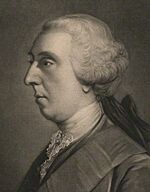 |
James Waldegrave
2nd Earl Waldegrave
|
8 June
1757 |
12 June
1757 |
5 days
|
– | Waldegrave | |||
Timeline
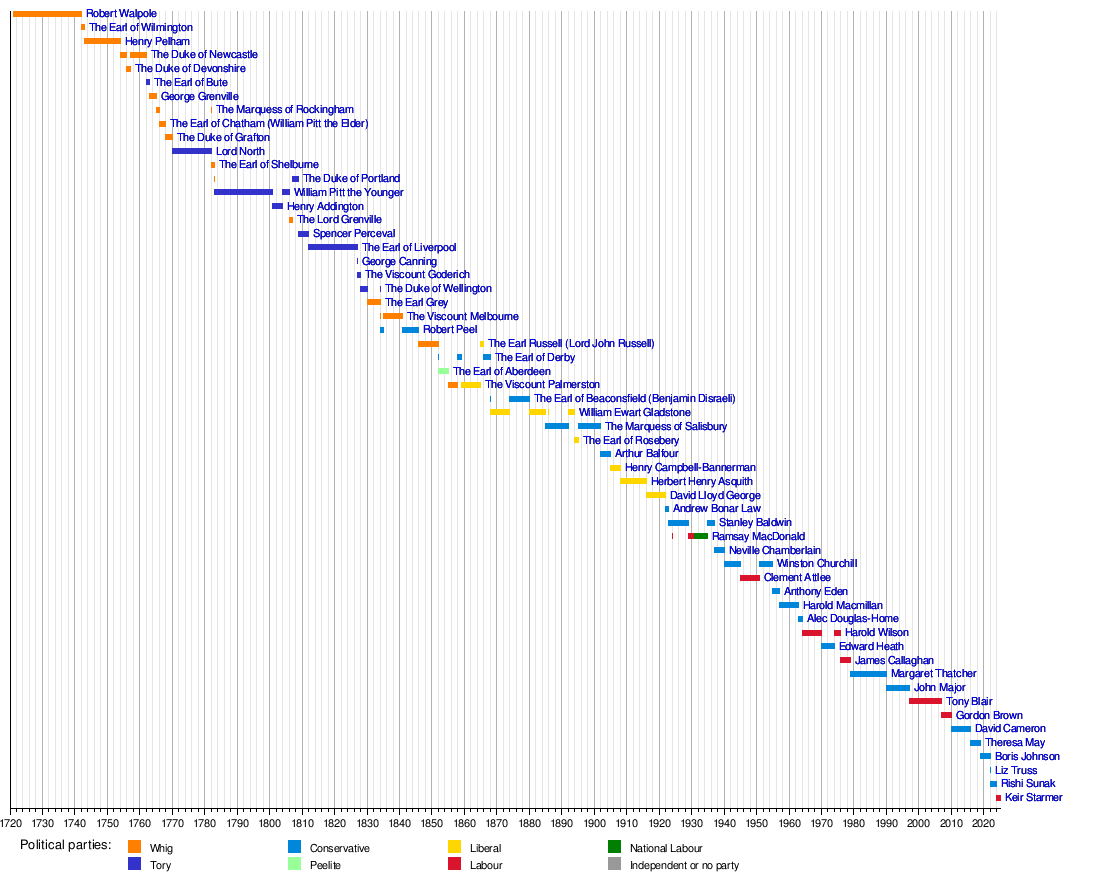
See also
 In Spanish: Anexo:Primeros ministros del Reino Unido para niños
In Spanish: Anexo:Primeros ministros del Reino Unido para niños
- List of prime ministers of the United Kingdom by length of tenure
- List of prime ministers of the United Kingdom by education
- Assassination of Spencer Perceval
- Downing Street
- List of British governments
- List of current heads of government in the United Kingdom and dependencies
- List of prime ministers of Queen Victoria (for the United Kingdom of Great Britain and Ireland and the British Empire)
- Deputy Prime Minister of the United Kingdom
- List of United Kingdom general elections
- Royal prerogative in the United Kingdom
- List of government ministers of the United Kingdom


